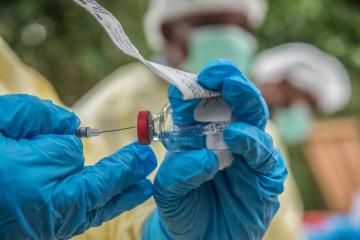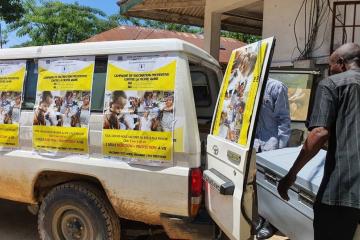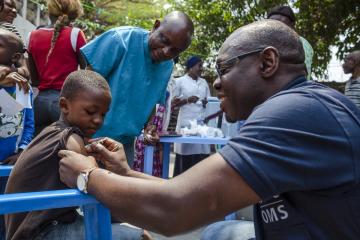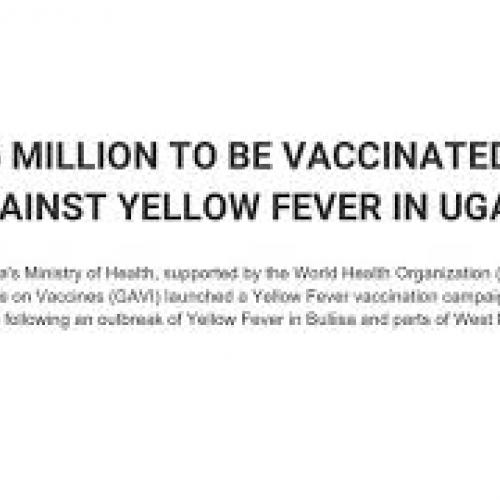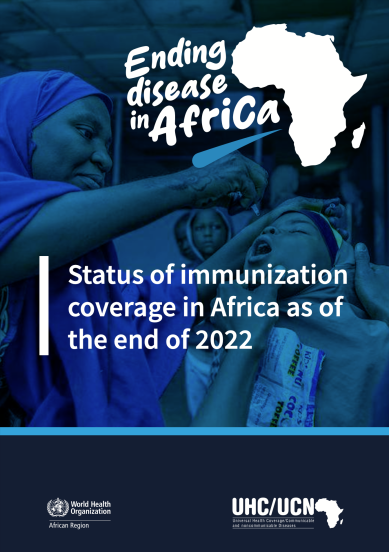Factsheet
Key Facts
- Yellow fever is an acute viral haemorrhagic disease transmitted by infected mosquitoes. The "yellow" in the name refers to the jaundice that affects some patients.
- Symptoms of yellow fever include fever, headache, jaundice, muscle pain, nausea, vomiting and fatigue.
- A small proportion of patients who contract the virus develop severe symptoms and approximately half of those die within 7 to 10 days.
- The virus is endemic in tropical areas of Africa and Central and South America.
- 27 countries are at highest risk for yellow fever epidemics in Africa.
- The burden of yellow fever in Africa is estimated at 84,000–170,000 severe cases and 29,000–60,000 deaths annually.
- In 2016, during the two-linked urban yellow fever outbreaks – in Angola and DRC – 965 cases were confirmed and around 400 people died. The epidemic created an urgent need for more than 28 million doses of yellow fever vaccines total, which exhausted the existing global vaccine supply. It also diverted public health authorities from tackling other public health issues with an impact on health systems. Additionally, 11 cases were exported to China.
- Since the launch of the Yellow Fever Initiative in 2006, significant progress in combatting the disease has been made in West Africa and more than 105 million people have been vaccinated in mass campaigns. No outbreaks of yellow fever were reported in West Africa during 2015.
- Large epidemics of yellow fever occur when infected people introduce the virus into heavily populated areas with high mosquito density and where most people have little or no immunity, due to lack of vaccination. In these conditions, infected mosquitoes transmit the virus from person to person.
- Yellow fever is prevented by an extremely effective vaccine, which is safe and affordable. A single dose of yellow fever vaccine is sufficient to confer sustained immunity and life-long protection against yellow fever disease and a booster dose of the vaccine is not needed. The vaccine provides effective immunity within 30 days for 99% of persons vaccinated.
- Good supportive treatment in hospitals improves survival rates. There is currently no specific anti-viral drug for yellow fever.
Once contracted, the yellow fever virus incubates in the body for 3 to 6 days. Many people do not experience symptoms, but when these do occur, the most common are fever, muscle pain with prominent backache, headache, loss of appetite, and nausea or vomiting. In most cases, symptoms disappear after 3 to 4 days.
A small percentage of patients, however, enter a second, more toxic phase within 24 hours of recovering from initial symptoms. High fever returns and several body systems are affected, usually the liver and the kidneys. In this phase people are likely to develop jaundice (yellowing of the skin and eyes, hence the name ‘yellow fever’), dark urine and abdominal pain with vomiting. Bleeding can occur from the mouth, nose, eyes or stomach. Half of the patients who enter the toxic phase die within 7 - 10 days.
Yellow fever is difficult to diagnose, especially during the early stages. More severe disease can be confused with severe malaria, leptospirosis, viral hepatitis (especially fulminant forms), other haemorrhagic fevers, infection with other flaviviruses (e.g. dengue haemorrhagic fever), and poisoning.
Blood tests (RT-PCR) can sometimes detect the virus in the early stages of the disease. In later stages of the disease, testing to identify antibodies is needed (ELISA and PRNT).
Forty seven countries in Africa (34) and Central and South America (13) are either endemic for, or have regions that are endemic for, yellow fever. A modelling study based on African data sources estimated the burden of yellow fever during 2013 was 84 000–170 000 severe cases and 29 000–60 000 deaths.
Occasionally travellers who visit yellow fever endemic countries may bring the disease to countries free from yellow fever. In order to prevent such importation of the disease, many countries require proof of vaccination against yellow fever before they will issue a visa, particularly if travellers come from, or have visited yellow fever endemic areas.
In past centuries (17th to 19th), yellow fever was transported to North America and Europe, causing large outbreaks that disrupted economies, development and in some cases decimated populations.
The yellow fever virus is an arbovirus of the flavivirus genus and is transmitted by mosquitoes, belonging to the Aedes and Haemogogus species. The different mosquito species live in different habitats - some breed around houses (domestic), others in the jungle (wild), and some in both habitats (semi-domestic). There are 3 types of transmission cycles:
- Sylvatic (or jungle) yellow fever: In tropical rainforests, monkeys, which are the primary reservoir of yellow fever, are bitten by wild mosquitoes which pass the virus on to other monkeys. Occasionally humans working or travelling in the forest are bitten by infected mosquitoes and develop yellow fever.
- Intermediate yellow fever: In this type of transmission, semi-domestic mosquitoes (those that breed both in the wild and around households) infect both monkeys and people. Increased contact between people and infected mosquitoes leads to increased transmission and many separate villages in an area can develop outbreaks at the same time. This is the most common type of outbreak in Africa.
- Urban yellow fever: Large epidemics occur when infected people introduce the virus into heavily populated areas with high mosquito density and where most people have little or no immunity, due to lack of vaccination. In these conditions, infected mosquitoes transmit the virus from person to person.
Good and early supportive treatment in hospitals improves survival rates. There is currently no specific anti-viral drug for yellow fever but specific care to treat dehydration, liver and kidney failure, and fever improves outcomes. Associated bacterial infections can be treated with antibiotics.
1. Vaccination
Vaccination is the most important means of preventing yellow fever. In high-risk areas where vaccination coverage is low, prompt recognition and control of outbreaks using mass immunization is critical for preventing epidemics. It is important to vaccinate most (80 % or more) of the population at risk to prevent transmission in a region with a yellow fever outbreak.
Several vaccination strategies are used to protect against outbreaks: routine infant immunization; mass vaccination campaigns designed to increase coverage in countries at risk; and vaccination of travellers going to yellow fever endemic areas.
The yellow fever vaccine is safe and affordable and a single dose provides life-long protection against yellow fever disease. A booster dose of yellow fever vaccine is not needed.
There have been rare reports of serious side-effects from the yellow fever vaccine. The rates for these severe ‘adverse events following immunization’ (AEFI), when the vaccine provokes an attack on the liver, the kidneys or on the nervous system, leading to hospitalization, are between 0.4 and 0.8 per 100 000 people vaccinated.
The risk is higher for people over 60 years of age and anyone with severe immunodeficiency due to symptomatic HIV/AIDS or other causes, or who have a thymus disorder. People over 60 years of age should be given the vaccine after a careful risk-benefit assessment.
People who are usually excluded from vaccination include:
- infants aged less than 9 months, except during an epidemic when infants aged 6-9 months, in areas where the risk of infection is high, should also receive the vaccine;
- pregnant women – except during a yellow fever outbreak when the risk of infection is high;
- people with severe allergies to egg protein; and
- people with severe immunodeficiency due to symptomatic HIV/AIDS or other causes, or who have a thymus disorder.
In accordance with the International Health Regulations (IHR), countries have the right to require travellers to provide a certificate of yellow fever vaccination. If there are medical grounds for not getting vaccinated, this must be certified by the appropriate authorities. The IHR are a legally binding framework to stop the spread of infectious diseases and other health threats. Requiring the certificate of vaccination from travellers is at the discretion of each State Party, and it is not currently required by all countries.
2. Mosquito control
The risk of yellow fever transmission in urban areas can be reduced by eliminating potential mosquito breeding sites by applying larvicides to water storage containers and other places where standing water collects. Insecticide spraying to kill adult mosquitoes during urban epidemics can help reduce the number of mosquitoes, thus reducing potential sources of yellow fever transmission.
Historically, mosquito control campaigns successfully eliminated Aedes aegypti, the urban yellow fever vector, from most of Central and South America. However, Aedes aegypti has re-colonized urban areas in the region, raising a renewed risk of urban yellow fever. Mosquito control programmes targeting wild mosquitoes in forested areas are not practical for preventing jungle (or sylvatic) yellow fever transmission.
3. Epidemic preparedness and response
Prompt detection of yellow fever and rapid response through emergency vaccination campaigns are essential for controlling outbreaks. However, underreporting is a concern – the true number of cases is estimated to be 10 to 250 times what is now being reported.
WHO recommends that every at-risk country have at least one national laboratory where basic yellow fever blood tests can be performed. One laboratory-confirmed case of yellow fever in an unvaccinated population is considered an outbreak. A confirmed case in any context must be fully investigated, particularly in an area where most of the population has been vaccinated. Investigation teams must assess and respond to the outbreak with both emergency measures and longer-term immunization plans.
WHO is supporting the roll-out of the preventive mass campaigns by providing technical support to governments in coordination with other partners, and training teams to conduct the large-scale campaigns.
WHO is supporting routine immunization by providing guidance on how to integrate Yellow fever vaccination at nine months with the standard measles vaccination to the five countries in Africa that have yet to commit to do this. WHO is supporting countries to increase their surveillance and build a strong laboratory network. WHO is helping to build better national laboratory capacities and expand the laboratory network. Early this year a second laboratory in the region, Uganda Virus Research Institute (UVRI) in Uganda has joined Institut Pasteur Dakar as a WHO regional reference laboratory.
WHO is the Secretariat for the International Coordinating Group for Yellow Fever Vaccine Provision (ICG). The ICG maintains an emergency stockpile of yellow fever vaccines to ensure rapid response to outbreaks in high risk countries.
In 2006, the Yellow Fever Initiative was launched to secure global vaccine supply and boost population immunity through vaccination. The Initiative, led by WHO and supported by UNICEF and national governments, has a particular focus on high endemic countries in Africa where the disease is most prominent. Since the Initiative was launched, significant progress has been made in West Africa to bring the disease under control. More than 105 million people have been vaccinated and no yellow fever outbreaks were reported in West Africa during 2015.
The Initiative recommends including yellow fever vaccines in routine infant immunizations (starting at age 9 months), implementing mass vaccination campaigns in high-risk areas for all people aged 9 months and older, and maintaining surveillance and outbreak response capacity.
Between 2007 and 2016, 14 countries have completed preventive yellow fever vaccination campaigns. The Yellow Fever Initiative is financially supported by the Global Alliance for Vaccines and Immunization (GAVI Alliance), the European Community Humanitarian Office (ECHO), the Central Emergency Response Fund (CERF), ministries of health, and country-level partners.
The Eliminate Yellow Fever Epidemics (EYE) Strategy was developed to respond to the increased threat of urban outbreaks of yellow fever with international spread[1].
The EYE strategy aims at building a global coalition of countries and partners to tackle the increased risk of yellow fever epidemics in a coordinated manner and is an opportunity to demonstrate new ways of managing the complex world of re-emerging infectious diseases.
It has three strategic objectives:
- protect at-risk populations
- prevent international spread, and
- contain outbreaks rapidly.
underpinned by five components:
- affordable vaccines and sustained vaccine market;
- strong political commitment at global, regional and country levels;
- high-level governance with long-term partnerships;
- synergies with other health programmes and sectors and;
- research and development for better tools and practices.
No country or institution can tackle the global issue of yellow fever epidemics alone. The EYE partnership is committed to combining its effort to eliminate yellow fever epidemics to main global health agendas, including global health security, health systems strengthening, and universal health coverage.
Demand for the yellow fever vaccine has recently increased due to the resurgence of yellow fever epidemics in Africa and Latin America, and the growing number of countries implementing routine immunization programmes.
- EYE works closely with manufacturers and at-risk countries to ensure vaccines are available in the locations and volume required.
- Yellow Fever vaccines are currently manufactured by four WHO-prequalified suppliers. Since 2001, annual yellow fever vaccine production has quadrupled from 20 million to 80 million doses. Output is estimated to increase even further in the coming years.
- The International Coordinating Group (ICG) on Vaccine Provision maintains an emergency stockpile of 6 million doses of yellow fever vaccine, funded by Gavi, which is continually replenished. This mechanism is ready to support countries to implement reactive vaccination campaigns quickly.
- 27 high-risk countries in Africa need large-scale, preventive vaccination strategies to establish and maintain high levels of immunity among their populations. 23 out of the 27 high-risk countries have introduced routine immunization programmes, which need to be sustained with high immunization coverages[2].
- 20 to 30 million children[3] need to be immunized annually, representing an annual demand of 35 to 50 million doses. The total vaccine demand for routine immunization over the next 10 years has been estimated at 465 million doses
- Target population for preventive mass campaigns in Africa is approximately 440 million, requiring 490 million doses of vaccine over ten years.
Sustained yellow fever control strategies must rely on strong surveillance and diagnostic capacities to allow for early detection of outbreaks and rapid implementation of control measures that can help mitigate the risk of spread and the use of extensive resources.
- By end 2018, two WHO regional reference labs are expected to be functional in Africa. Another laboratory in the region will join the Institut Pasteur Dakar to build in-country laboratory capacity by training national labs, confirming yellow fever cases, providing reagents, etc. With a faster and reliable laboratory network, countries will be able to implement faster responses.
Eliminating Yellow Fever Epidemics (EYE) Strategy: Meeting demand for yellow fever vaccines
[1] Steered by WHO, UNICEF, and Gavi, the Vaccine Alliance, EYE supports 40 countries and involves more than 50 partners. The EYE strategy was endorsed by the Strategic Advisory Group of Experts on Immunization (SAGE) in October 2016 and approved by the Gavi Board in December 2016. The strategy will succeed by engaging countries and multidisciplinary partners, and by coordinating efforts well.
[2] Four out of the 27 high-risk countries (Ethiopia, South Sudan, Sudan and Uganda) have not yet introduced routine immunization, but it is expected that they do so by the end of 2020. Kenya has already committed to increase the number of counties where routine immunization is introduced.
[3] counts increasing from 2017 to 2026 due to natural population growth



